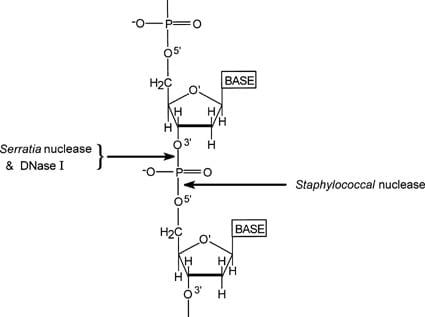Figure 1. The cleavage sites for DNase I, Staphylococcal nuclease and Serratia nuclease on a polynucleotide substrate
Effect of Conditions on Activity
It requires Mg2+ or Mn2+ for activity and displays a broad pH range from 6 to 10 (optimal at 8 – 8.5) and a wide temperature optimum between 35℃ and 44℃. Maximal activity obtained with 10 mM MgCl2 was three times that attained with 1 mM MnCl2. 1 mM EDTA reduced the activity by 30% in the presence of 1 mM MgCl2; 0.1 M EDTA eliminated all enzyme activity. In the presence of 1 mM MgCl2, enzyme levels were reduced 75% by 0.1 M CaCl2 or 1 M NaCl. Under standard assay conditions, 1 mM iodoacetate had no effect on the enzymatic rate, whereas 1 mM mercaptoethanol and maleic acid reduced the activity by only 5 to 10%. 10 mM p-Chloromercurybenzoate completely inactivated the enzyme, while 0.64 M beta-mercaptoethanol in the presence of 3 M urea caused only partial inactivation of the enzyme. 4 or 7 M Urea increases the enzyme activity.
Absence of Protease Activity
Absence of protease activity for SuperNuclease is guaranteed by a highly sensitive and validated assay using an azo-casein as substrate. This ensures that applying SuperNuclease in protein production process will yield high quantity and quality protein.
Removal of SuperNuclease
SuperNuclease used in downstream processing can be removed by various purification methods according to the purification strategy for the target protein.
Applications
Its high intrinsic activity and broad substrate tolerance make the endonuclease an ideal tool in a variety of biotechnological and pharmaceutical applications
| Downstream processing | |
| 1. Removal of nucleic acid contamination from purified proteins, commonly from recombinant DNA products. | |
| 2. Reduction of viscosity for subsequent processing steps. | |
| Environmental protection | |
| 1. A killer gene for the self destruction of microorganisms released into the environment. | |
| Novel applications | |
| 1. Anti-viral agent; use for antiretroviral therapy; anti-tumor properties |
Formulation
50mM Tris, 20mM NaCl, 2mM MgCl2, pH 8.0
Quality Assurance
| Purity | The purity of each lot was determined by SDS-PAGE |
| Activity Assay | |
| Unit definition: | One unit of SuperNuclease is defined as the amount of enzyme that causes a △A260 of 1.0 in 30min at 37℃, which corresponds approximately to complete digestion of 37 μg DNA. Note that 1KU=1000 units. |
| Procedure | |
| 1. Reagents and solutions preparation | |
| Reaction buffer: | 50 mM Tris-HCl, 5 mM MgCl2, pH 8.5 |
| Substrate: | 1mg/ml salmon sperm DNA in reaction buffer |
| Enzyme: | Different dilution of nuclease with reaction buffer |
| Stop reagent: | Trichloroacetic acid (TCA) |
| 2. Standard curve establishment | |
| 400 μl substrate + 100 μl enzyme of known activity = 500μl mixture | |
| 1. Incubate the mixture at 37℃ for 30min. | |
| 2. Stop the reaction by addition of 0.5 ml cold TCA and incubate on ice for 10 min. | |
| 3. Centrifuge at 8000g for 5 min. | |
| 4. Measure the absorbance of supernatant at 260 nm. | |
| 5. lot a standard curve with nuclease of known activities for each set of measurements. | |
| 3. Measurement of activity | |
| The activity of any unknown nuclease can be determined from a single measurement by means of the standard curve. The specific activity of SuperNuclease is 1.3×106 ~ 1.5×106 unit/mg protein. |
